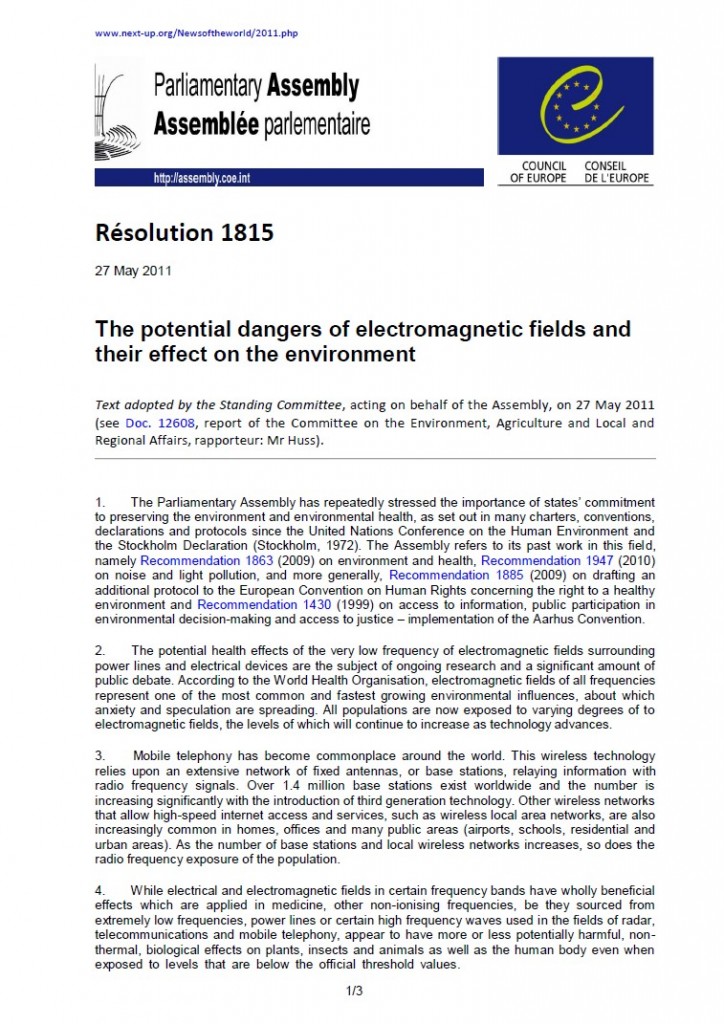Portada del sitio > Estudios Científicos > Treatment of advanced hepatocellular carcinoma with very low levels of (...)
British Journal of Cancer (2011) 105, 640-648.
Treatment of advanced hepatocellular carcinoma with very low levels of amplitude-modulated electromagnetic fields
Sábado 3 de diciembre de 2011 · 1339 lecturas
Treatment of advanced hepatocellular carcinoma with very low
levels of amplitude-modulated electromagnetic fields
FP Costa*,1, AC de Oliveira1, R Meirelles1, MCC Machado1, T Zanesco1, R Surjan1, MC Chammas2,
M de Souza Rocha2, D Morgan3, A Cantor4, J Zimmerman5, I Brezovich6, N Kuster7, A Barbault8
and B Pasche*,5
1Department of Transplantation and Liver Surgery, Hospital das Clı’nicas da Faculdade de Medicina, University of Sa�o Paulo, Av. Dr. Ene’as de Carvalho
Aguiar, 255, Sa�o Paulo 05403-000, Brazil; 2Department of Radiology, Hospital das Clı’nicas, University of Sa�o Paulo, Sa�o Paulo 05403-000, Brazil;
3Department of Radiology, University of Alabama at Birmingham and UAB Comprehensive Cancer Center, Birmingham, AL 35294, USA; 4Biostatistics
and Bioinformatics Shared Facility, University of Alabama at Birmingham and UAB Comprehensive Cancer Center, Birmingham, AL 35294, USA; 5Division
of Hematology/Oncology, Department of Medicine, University of Alabama at Birmingham and UAB Comprehensive Cancer Center, 1802 6th Ave South,
NP 2566, Birmingham, AL 35294-3300, USA; 6Department of Radiation Oncology, The University of Alabama at Birmingham and UAB Comprehensive
Cancer Center, Birmingham, AL 35294, USA; 7IT’IS Foundation, Swiss Federal Institute of Technology, Zurich, Switzerland; 8Rue de Verdun 20, Colmar
68000, France
BACKGROUND: Therapeutic options for patients with advanced hepatocellular carcinoma (HCC) are limited. There is emerging
evidence that the growth of cancer cells may be altered by very low levels of electromagnetic fields modulated at specific frequencies.
METHODS: A single-group, open-label, phase I/II study was performed to assess the safety and effectiveness of the intrabuccal
administration of very low levels of electromagnetic fields amplitude modulated at HCC-specific frequencies in 41 patients with
advanced HCC and limited therapeutic options. Three-daily 60-min outpatient treatments were administered until disease
progression or death. Imaging studies were performed every 8 weeks. The primary efficacy end point was progression-free survival
X6 months. Secondary efficacy end points were progression-free survival and overall survival.
RESULTS: Treatment was well tolerated and there were no NCI grade 2, 3 or 4 toxicities. In all, 14 patients (34.1%) had stable disease
for more than 6 months. Median progression-free survival was 4.4 months (95% CI 2.1-5.3) and median overall survival was 6.7
months (95% CI 3.0-10.2). There were three partial and one near complete responses.
CONCLUSION: Treatment with intrabuccally administered amplitude-modulated electromagnetic fields is safe, well tolerated, and shows
evidence of antitumour effects in patients with advanced HCC.
British Journal of Cancer (2011) 105, 640-648. doi:10.1038/bjc.2011.292 www.bjcancer.com
Published online 9 August 2011
& 2011 Cancer Research UK
Keywords: hepatocellular carcinoma; phase II study; radiofrequency electromagnetic fields; tumour-specific modulation frequencies;
27.12 MHz
—
Ver el artículo original completo en pdf
NEWS:
New non-invasive technology shows promise in shrinking liver tumors
By Nicole Wyatt
A potential new option is beginning to emerge for patients with the fastest growing form of cancer in the United States, according to researchers at the University of Alabama at Birmingham.
liver_storyIn a phase II study, 41 patients with hepatocellular carcinoma (HCC), a liver cancer that often does not respond well to chemotherapy, were treated with very low levels of an electromagnetic field emitting from a spoon-like device placed in the patients’ mouths.
After six months, the tumors in 14 patients had stabilized after each received three one-hour treatments per day each day; the therapy created no significant side effects. The most successful tumor shrinkage occurred in a female patient who has received regular therapy since August 2006; her tumor continues to shrink without serious side effects.
Boris Pasche, M.D., Ph.D., director of the UAB Division of Hematology and Oncology in the Department of Medicine, and collaborators reported their findings Aug. 9, 2011, in the online version of the British Journal of Cancer.
“The very appealing advantage of this novel therapy is its capability to shrink tumors without collateral damage. This method literally finds cancer cells in the body and blocks their growth without affecting the growth of normal cells,” says Pasche, senior author of the study.
To date, other treatment options have been limited. The U.S. Food and Drug Administration has only approved one drug, sorafenib, in 20 years. Pasche says this drug does prolong life an average of three months, but it doesn’t make the patient feel better.
“With our treatment, seven of the 11 patients who reported pain prior to the start of their treatment reported either a complete disappearance of pain or decreased amounts,” says Pasche. Preliminary evidence also indicates that the treatment not only affected the primary cancer, but also its metastases.
The small battery-driven “radio frequency electromagnetic field generator” has an attached spoon-shaped mouthpiece. The device is programmed and the patient pushes a button to start treatment. It is like a watch in that it emits low levels of amplitude-modulated radio frequency, resulting in the delivery of doses 100 to 1,000 times less than those generated from a cell phone.
“When you take the mouthpiece and put it in your mouth the body becomes an antenna - the whole body receives a tiny but fairly homogenous amount of radio-frequency,” Pasche says.
In a 2009 study, Pasche and research partners Alexandre Barbault in France and Frederico Costa at the University of Sao Paulo in Brazil identified tumor-specific frequencies and tested the feasibility of administering such frequencies to patients with advanced cancer. They then decided to determine whether these frequencies had an effect on the growth of tumors.
Pasche believes this a promising therapy that could become a standard of care in the near future. The therapy is ready for an FDA-registration study and randomized trials, which will be initiated at UAB upon funding being secured for the project. Pasche disclosed on the paper that he has “filed a patent related to the use of electromagnetic fields for the diagnosis and treatment of cancer.” He also disclosed that he is a founding member of TheraBionic LLC.
“Although liver transplant is the most effective treatment, that option will be available for only a fraction of patients. Better therapies are sorely needed for the larger number of HCC patients,” Pasche says.
Ver la noticia original AQUÍ







